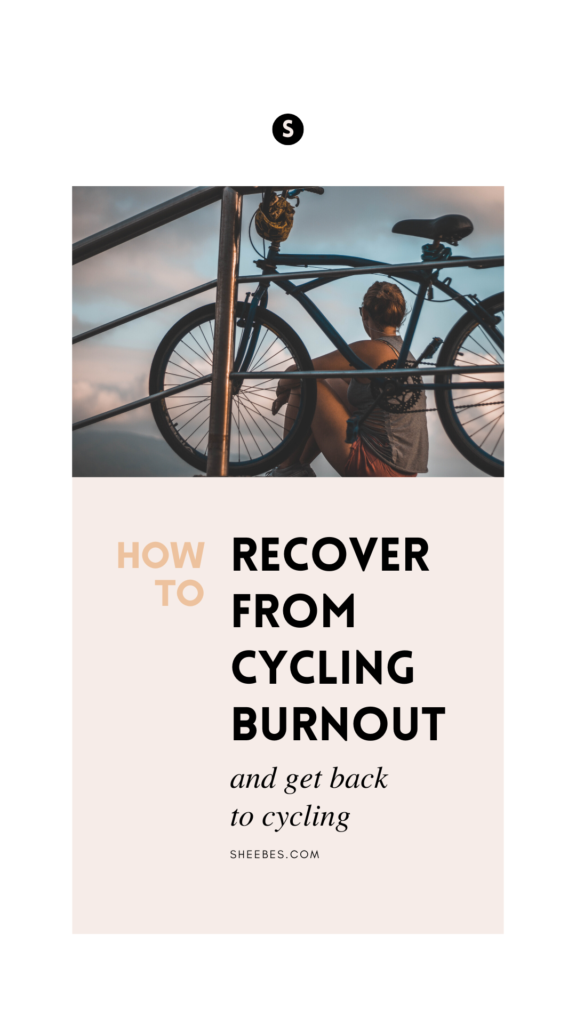Are you a little burnt out on cycling? It’s normal to have dips in motivation, but if you’ve been consistently tired, your fitness has plateaued, or you’ve been more irritable than usual, you may have cycling burnout.
So if you suspect you’re facing cycling burnout, this post is for you.
We’ll talk more about cycling burnout, how to spot cycling overtraining symptoms, and how to recover from cycling burnout and cycling overtraining.
Let’s get started.

Whether you’re a runner looking for running tips or a cyclist searching for cycling advice, this site is here to help you elevate your fitness game.
Affiliate Disclosure: I’m here to help you grow as a rider and runner. So to keep things running smoothly and the content free, I participate in the Amazon Services program and select affiliate networks. So, when you click on those affiliate links, I earn a small commission at no extra cost to you.
WHAT IS CYCLING BURNOUT?
Cycling burnout happens when you ride your bike often without taking enough time to rest and recover.
You wouldn’t go from perfectly fine to burnout in an instant. Cycling burnout runs on a spectrum—from overreaching to overtraining. We’ll dive into the details in a moment.
But first, an important note.
Cycling burnout is one area to consider, but you may want to dig into some other areas of your life to see if anything else has been affecting your cycling.
A few other areas to look at are:
- The amount of stress you’ve been under recently. If you’ve been under a lot of stress, you probably won’t have enough energy for demanding bike workouts.
- Your food intake. Have you been eating enough to fuel your rides?
- Sleep. Have you been sleeping well? Or have your sleep habits changed recently?
A LITTLE MORE ABOUT CYCLING BURNOUT
Cycling burnout runs on a spectrum—from overreaching to overtraining.
Though overreaching places you at a higher risk of overtraining, this stage can be useful.
Functional overreaching—training hard, followed by rest—may be a deliberate part of a cycling training plan to help you boost your performance.
But the cycle of training hard and recovering well is tricky because everyone’s different—we all respond to hard training differently and recover on different timelines.
Some of us may need less cycling recovery time and some more. Because of this, it’s easy to tip the scales into too much training and not enough recovery.
If you’ve spent too much time overreaching, you’ll see your cycling performance decline, and you might also be more tired from cycling and irritable.
Don’t try to muscle your way through this because that could push you into a more severe form of cycling burnout—overtraining.
How to recover from this stage of cycling burnout: rest anywhere from a few days to a few weeks. Step away from your bike, eat your carbs, and sleep.
It may help to write notes on how you feel throughout your rest period, so you know how you’ve been recovering and when you feel fresh enough to return to cycling.
I’ve got a spot for you to write notes and more in this 12-week return to cycling plan. Click the learn more button below for more details on this return to cycling plan.
HOW TO SPOT CYCLING OVERTRAINING SYMPTOMS
Remember, cycling burnout runs on a spectrum—from overreaching to overtraining.
Overtraining happens when you’ve let overreaching (riding your bike without enough rest) continue.
The biggest difference between overreaching and overtraining is the time you’ll need to recover—weeks vs. months.
You’ll recover from overreaching in a few weeks, but recovering from overtraining takes months.
So if you have this question, “How do I know if I am overtraining with cycling?”
The signs of overtraining in cycling vary by person, but some cycling overtraining symptoms are:
- Premature fatigue
- A decline in performance
- Mood changes
- Decreased motivation
- Little to no cycling rest days
- Poor performance in races
- Personal and emotional stress
- Disturbed sleep
- Frequent sickness
- No progress in performance
- A decrease in strength and fitness
HOW DO YOU RECOVER FROM CYCLING OVERTRAINING?
No cycling workouts for at least 4 weeks, but you may need more because recovery length varies by person. Unfortunately, the only way out of cycling overtraining is to rest.
After a month of no cycling, you will most likely feel better, but that won’t necessarily mean you’ve fully recovered from cycling overtraining. It may still be too early for you to jump back into the same amount of cycling you did.
It’s frustrating that there’s no concrete timeline for recovering from overtraining.
But much like overreaching, it’ll be helpful to write notes on how you feel throughout your rest period, so you know how you’ve been recovering and when you feel fresh enough to return to cycling.
When you return to cycling after overtraining, do this slowly and gradually.
Start with short, relaxed bike rides, and then see how you feel after your ride. If you don’t feel good, take more time to rest, sleep, and eat well.
Getting back into cycling after a few weeks off can be a slow process with no clear steps forward.
So if you’d like more cycling tips to guide you on your return to cycling, this 12-week return to cycling plan may be for you.

Sources
Physiological Perspective of Endurance Overtraining – A Comprehensive Update